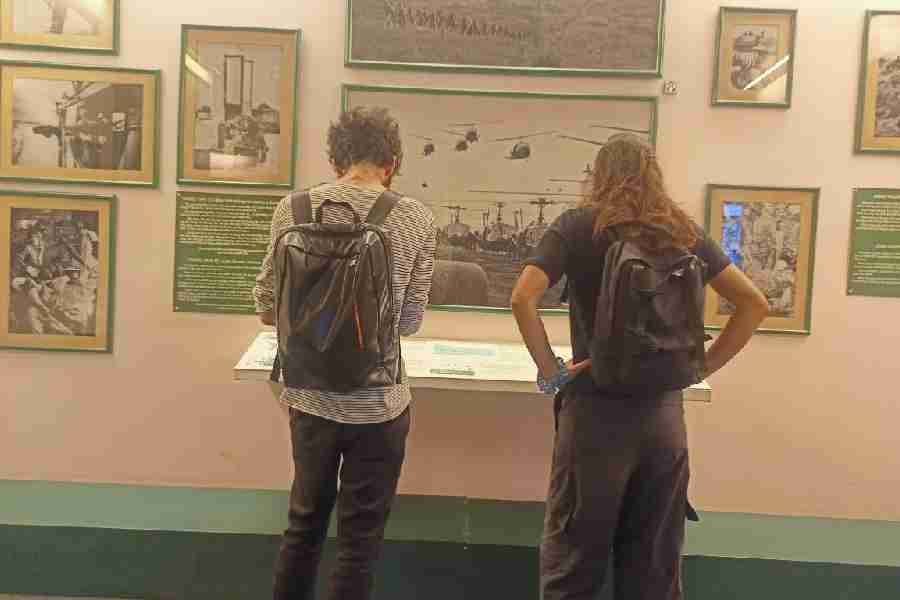Vietnam. The tiny country that defeated the mighty US. That’s one of the things that comes to mind when you hear the name. It was a war the Vietnamese fought not with large battalions and heavy artillery but their blood and very breath.
On one side was Communist North Vietnam and its allies, together called the Viet Cong. On the other side, South Vietnam and its main ally, the US. The massive conflict — that stretched over 20 years — lives to this day, enshrined in a museum in Ho Chi Minh City. People still love to call the place Saigon, the salubrious city where food is spread on its thoroughfares and music flows in its rivers.
The War Remnants Museum is not huge by any standard. It is a neat three-storey building standing on well-kept grounds. The gleaming warcraft in the open area make for a great photo opportunity. Menacing though they appear, their vintage bearings allow the cushioning of passage of time. There’s a cafe too, lined by an arched bamboo grove. Unavoidable perhaps, for visitors who might need some mending after experiencing the innards.
And yet, one must wade through the audios and maps, facts and figures, stories and photographs to remind oneself just how brutal man can be. Categories of exhibits include a mapping of the war’s political range, a photo collection of war correspondents who died in action, a special collection by Japanese photographer Ishikawa Bunyo, Agent Orange and its effects, war crimes and so on.
Sample this. A photograph on the third floor shows rows of dead and mangled Vietnamese figures. Below it is a terse caption — “Body Count: A US military’s yardstick to measure the success for the war: ‘If it’s dead, it’s Viet Cong.’”
Here’s another you cannot unsee, even after days. It’s of a young man with dark hair, soulful eyes and a cigarette hanging loosely from the corner of his mouth. It’s titled “The Death of Robert Capa”. A photojournalist, Capa was the first press casualty. The longish caption, lifted from the reportage by a Time-LIFE correspondent, reads: “One camera was clutched in his left hand. I began calling his name. The second or third time his lips moved slightly like those of a man disturbed in sleep. That was his last movement. It was 3.10pm. The doctor asked, ‘Is this the first American correspondent killed in Indochina?’ I said yes. He said, ‘It is a harsh way for America to learn.’”
Two photographs and a horror story. A young Bob Kerrey as a soldier and as a grey-haired US senator. The horror goes thus: “(sic) From 8 PM to 9 PM February 25, 1969, a group of Seal Rangers (one of the most selective rangers of U.S. Army) led by Lieutenant Bob Kerry reached for Hamlet 5, Thanh Phong Village, Thanh Phu District, Ben Tre Province. They cut 66 year-old Bui Van Vat and 62 year-old Luu Thi Canh’s necks and pulled their three grandchildren out from their hiding place in a drain and killed two, disembowelled one. Then, these rangers moved to dug-outs of other families, shot dead 15 civilians (including three pregnant women), disembowelled a girl... It was not until April 2001 that the U.S. Senator Bob Kerrey confessed his crime to the international public.”
Is this a battle in the last century? The mind does its own associations, permutations, combinations. Disembowelled was also what happened in the Delhi bus rape incident. And pregnant women being slaughtered... why does that take us to 2002?
Also on display is the drain from which the children were pulled out. A concrete, in-your-face structure that could, once again, belong anywhere... Ukraine even.
The Mai Lai massacre photos are in colour; and of course, it needn’t be said which colour is most prominent. Alongside an image is a fat caption, both by a US Army photographer: “As I entered the hamlet of Mai Lai 4, I photographed a house that had been set on fire. I remember that the body in front of the burning house kept twitching, and one soldier commented, ‘He got ghosts in him.’”
In a different enclosure, a huge work of art is stretched on the wall. It is a self-portrait by Heather Morris, a 50-year-old artist who lives in Ohio, US. The canvas here shows a disabled young woman carrying on her slumped shoulders the burden of war. Although it was a war she was in no position to understand, because she wasn’t even born then.
But her father was there; he served in Vietnam for a year, in areas sprayed with Agent Orange. The US forces used the herbicide, among other chemicals, to kill forests and vegetation. Apart from killing over seven lakh people, Agent Orange left unborn children with deformities, for generations, especially in South Vietnam.
Away from the museum, in another part of the world, a government document reads “On May 14, 1970, Kerrey was one of 12 service members to receive the Medal of Honor from President Richard M. Nixon during a White House ceremony...”










